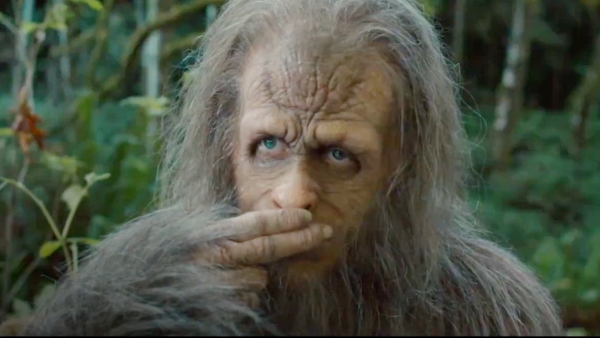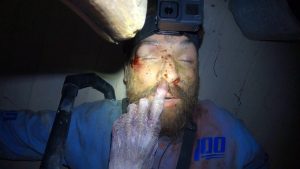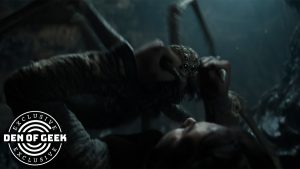
A bewildering little cryptid curio from David Zellner and Nathan Zellner, a.k.a. the Zellner Brothers (Kumiko the Treasure Hunter, Damsel), Sasquatch Sunset is entirely its own vibe. Wholly free of dialogue and featuring a family of four Sasquatchs living their feral lives somewhere in the Pacific Northwest, their film is an arthouse experiment with form that weasels its way under the skin to draw out questions of man’s impact on the natural world. Including the fictional Yeti living in their forests. Despite featuring plenty of Sasquatch defecation, Sasquatch genitals, and Sasquatch fornication, the Zellners’ latest film, as if made for those who thought the opening shot of 2001: A Space Odyssey could have sustained an entire creature feature, is oddly affecting, coaching an environmental plea inside an otherwise obscene portrait of untamed existence.
Unfolding over the course of a year as told in four seasonal chapters, Sasquatch Sunset is the Zellners reckoning with the natural order and man’s disruption of it. Sparse and juvenile – including all sorts of scatological Bigfoot biology – it’s also kind of hard to look away from. The Zellners’ account bears witness to the cryptid family foraging for food, building shelter, interacting with other wildlife, and playing scratch and sniff their nether regions. The Zellners do find pockets of humor in the grotesque but the film’s gross-out gags are truly just an extension of the natural world, which doesn’t care for manners and is ruled largely by entropy. This entropy manifests in some startling, sobering sequences, spotlighting the thin line between survival and oblivion under natural order.
Jesse Eisenberg and Riley Keough both inexplicably star in the movie, each done up in full ‘quatch regalia, for reasons perhaps beyond any mortal’s comprehension. The heavy prosthetics used to create the practical look of the simian-humanoid creatures and the fact that no performer delivers a single line of dialogue limits their performance entirely to their physicality, usually grounded in their eyes. When the Bigfoot gang aren’t hooting and hollering, they’ll steal glances – either in animal lust, defensive territorialism, or ruminative contemplation. The specter of encroaching industrialization, found in mankind’s ominous markings that frequently accompany wonder and loss, suggests the invasive machinery and forestry to come.
The zen-ed out score composed by the The Octopus Project and natural beauty of the film captured by Mike Gioulakis help pull you into this kind of trance-like state that helps deliver on the almost- documentarian wonder that the Zellners aim to create. Casual moviegoers won’t likely gravitate towards the Zellner’s most recent fare as its decidedly unique wavelengths will leave many wondering what the hell they watched and why. But despite its almost total commercial appeal, Sasquatch Sunset is boldly its own bag. To whittle it down to its commercial appeal or being good or bad is to miss the point. It just is.
CONCLUSION: A zen-like look at a family of four Sasquatches over the course of a calendar year, ‘Sasquatch Sunset’ is the Zellner Brothers’ bold take on an environmentalist movie, one that tucks into the feral and entropic state of the natural world with gross-out aplomb.
B-
For other reviews, interviews, and featured articles, be sure to:
Follow Silver Screen Riot on Facebook
Follow Silver Screen Riot on Twitter
Follow Silver Screen Riot on Instagram
The post ‘SASQUATCH SUNSET’ Jettisons Dialogue for Naturalistic Study of Being appeared first on Silver Screen Riot.




